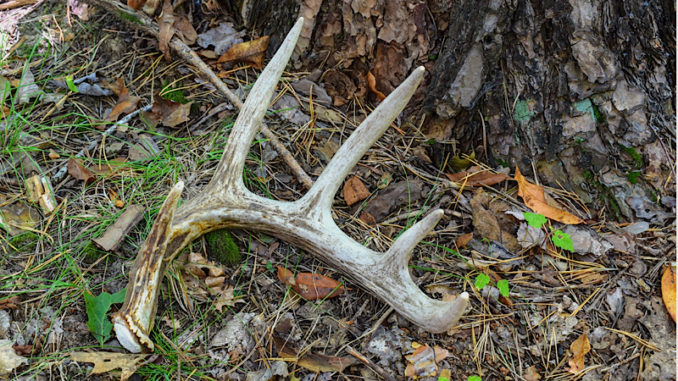
It’s time to find some shed antlers
Hunting whitetail deer throughout the Carolinas involves year-round scouting and preparation to truly have the opportunity to bag a trophy buck. Mature bucks are sneaky and mysterious. But they always leave a mark. For instance, they cannot walk without leaving evidence of imprints in the soil or being spotted traveling across highways and through fields at night during the rut. And by springtime, bucks have shed their antlers, leaving hunters lots of clues.
Hunters utilize many tools to identify these majestic animals. And collecting sheds still remains an important tactic for identifying the quality of bucks utilizing a property. It also helps identify their late-season hangouts.Throughout the first four or five years of a male deer’s life, he will generally grow larger antlers during consecutive years, but with similar, recognizable traits. Any shed with 4- to 5-inch bases and three to five points is a marker for a big trophy buck that made it to the next hunting season.
The shed and its location aids the hunter in identifying specific bucks using the habitat and actual travel routes or areas these deer frequent in the later part of the season. Bucks will use different areas in the late summer and early fall. But their mere presence on the property is always an added bonus in determining buck usage.
A little searching can yield big rewards
Antlers begin to loosen towards the end of December, but they will not usually detach until several weeks afterwards in January and February. Through March, all antlers should have detached completely, launching the race for sheds. Actually, sheds really do not go anywhere. But over time, wind-blown leaves and woody debris will conceal them. And calcium-deficient rodents will eat them.
Typically, hunters find sheds around abundant winter food sources, heavy travel routes, or bedding areas. During March, food sources are diminishing quickly — with the exception of winter agriculture cover crops or winter food plots specifically maintained for deer overwintering. These winter food sources are prime areas to find sheds. Using binoculars to scan fields on a daily basis will show any antlers dropped the night or several days before. Food is scarce this time of year, and travel routes are relatively undisturbed and heavily used. The trails leading to and from the food sources are prime locations to find sheds.
Some bedding areas are too thick to get into. But deer will bed in areas they can see great distances around, such as fallen trees in open woods or hedgerows. Hunters combing for sheds at the end of the shedding season can covering a lot of ground.
Trail cameras can also be used around natural food sources or bait piles. As soon as the sheds release, the trail camera photos will reveal bucks without antlers. This will clue you in on when it becomes time to search for the fallen sheds around the food source or on the trails leading to and from.
The Permanent Food Plot
Food plots are great wildlife depots and should be part of any wildlife-management plan. But they require routine maintenance which can be quite intense. However, mast-producing trees produce every year with little to no maintenance. The planting season for many wildlife-friendly plants occurs from May through November. But mast-producing trees should be planted anytime during the winter when the soil temperature is still cool. March is a great time to plant wildlife-friendly mast trees.
Wildlife prefer a variety of mast-producing trees, including soft- and hard-mast producers. A mixture of soft- and hard-mast trees should be planted to provide a wide range of foods and nutrition for wildlife to eat. The variety of mast trees also will attract several different species of wildlife.
Soft-mast trees are great for the ease of planting and quick fruit production. A soft-mast tree is just a fancy term for a fruit tree. Unlike hard-mast trees, soft-mast producers can drop a successful crop within several years after planting. And they will continue to produce every year afterwards. Deer and other animals will go out of their way to visit these trees when fruits begin to ripen. Persimmon, crabapple, pear, apple, and plum trees are among the easiest to plant. They also prove to be great producers, and highly-favored among game species in the Carolinas.
Hard mast-producers take more time to establish and produce a viable crop. But they provide viable nutrition and are important in a long-term wildlife management plan. While many species of oak can be planted, the exotic sawtooth oak is favored among wildlife managers for its quick growth and acorn characteristics. Sawtooth oak acorns are similar to white oak acorns and are highly favored among whitetail deer. Sawtooth oak produce a large quantity of acorns, and they will ripen before native oaks, providing an early food source.




Be the first to comment